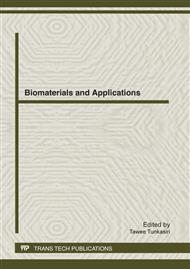p.560
p.563
p.567
p.571
p.575
p.579
p.583
p.587
p.591
Cheap Media for Inoculum Preparation of Acetic Acid Bacteria
Abstract:
Acetic acid bacteria are used in the production of many kinds of food product: Acetobacter aceti, a starter culture of vinegar fermentation; Acetobacter xylinum, a starter culture of bacterial cellulose production (nata de coco). The objective of this research was to find cheap media for the preparation of seed culture of these bacteria. Coconut water, banana juice and a mixture of coconut water and banana juice (ratio 1:1) were used as inoculation media and compared with HS and GEY, the commonly used media for acetic acid bacteria. Acetobacter aceti TISTR102, Acetobacter xylinum TISTR975, Acetobacter xylinum AGR60 and the isolated Acetobacter xylinum Coc5 were used as the test strains. The pH and total sugar of all media were adjusted as the control media (HS & GEY) at 5.0 and 2% (w/v), respectively. The results found that all strains grew well in each medium and viable cells achieved the level of at least 106 CFU/ml when cultured for 12 hours at 30°C, 200 rpm. The result shows that constitutes of agricultural product such as coconut water and banana juice can be used as cheap inoculation media for acetic acid bacteria.
Info:
Periodical:
Pages:
575-578
Citation:
Online since:
April 2012
Authors:
Keywords:
Price:
Сopyright:
© 2012 Trans Tech Publications Ltd. All Rights Reserved
Share:
Citation:


